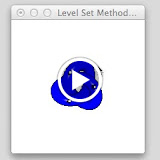in Japanese
Introduction
I have recently extended
the previous implementation of the Level Set Method so that it can be applied to arbitrary 3D shapes. In this page, I would like to provide you with a brief explanation on the new implementation.
In order to accomplish the purpose, I used
Open Asset Import Library (Assimp). The library allows us to load various 3D format files and to extract 3D information through the common interfaces the library comes with. I have made it possible for my engine to accept the STL format, which is one of 3D model formats, as an input.
Installation of Assimp Library
As MacPorts has it, we can easily install it as follows:
What's STL?
The following are a brief description:
- It's an abbreviation for Stereo Lithography.
- It describes a static 3D object.
- It describes the object as a set of triangles.
- The vertices of the triangle are listed in a counterclockwise order.
- A normal vector for the triangle may also be listed. The vector is an unit one.
- The STL file begins with
solid, and ends with endsolid.
- It has the format of either ASCII or BINARY.
- It has no color information.
- It has no compression.
- It has 1 image.
For example, the STL file looks like this:
Extraction of 3D information
We can extract three vertices and one normal vector for each triangle through the interfaces Assimp Library provides.
In the 3D case, my implementation of the Level Set Method expects a std::uint8_t array with size of
width x
height x
depth as input. The pixels on the surface of the object should be set to 128, and other pixels to 255.
The procedures to convert the STL format into my requirement are as follows:
- The scale conversion and the parallel shift are applied to an object to put it inside a box with the size of width x height x depth.
- We find the 3D point (int-type) that has the distance less than 1 from each triangle and exists inside the triangle.
- The pixel value is set to 128.
The adjacent pixels of the surface of the object has 128 and other pixels are set to 255.
Results
There are some demo movies below. All inputs have the size of 200x200x200 pixels.
I downloaded some STL files from
this site.
Development Environment
- Mac OS X 10.8.2
- Processor:3.06 GHz Intel Core 2 Duo
- Memory:4GB
- Xcode4.6 with Apple LLVM 4.2(C++ Language Dialect → C++11, C++ Standard Library → libc++)
- boost-1.51.0 built by the Apple LLVM 4.1. See here
- opencv-2.4.3 built by the Apple LLVM 4.2. See here.
- assimp @3.0.1270 (MacPorts's package. Though MacPorts uses the different compiler from the one Xcode has, fortunately my implementation works well.)
My Source Code
Here is my source code. I tested it on the above environment.
The C++11 new features, such as lambda expression and thread library, are used to implement my engine.
Usage
See
here.
Execution Command
The execution command looks like this:
As soon as you type the return key, the application enters the pause mode. The calculation begins after typing 'p'.



